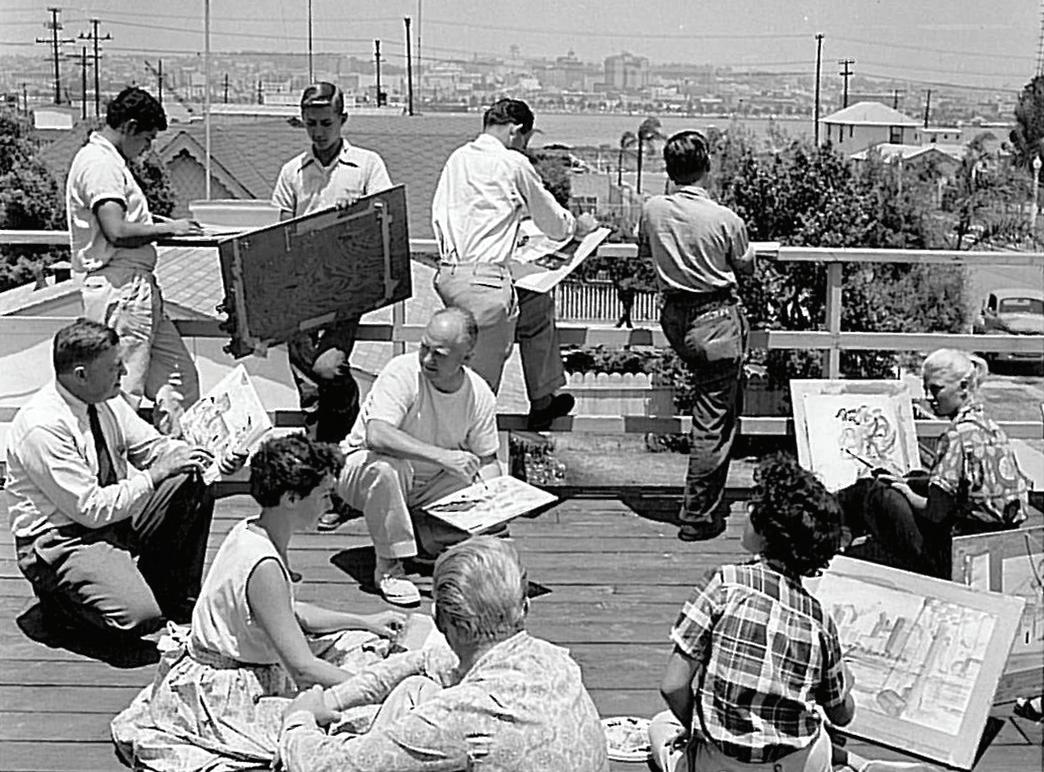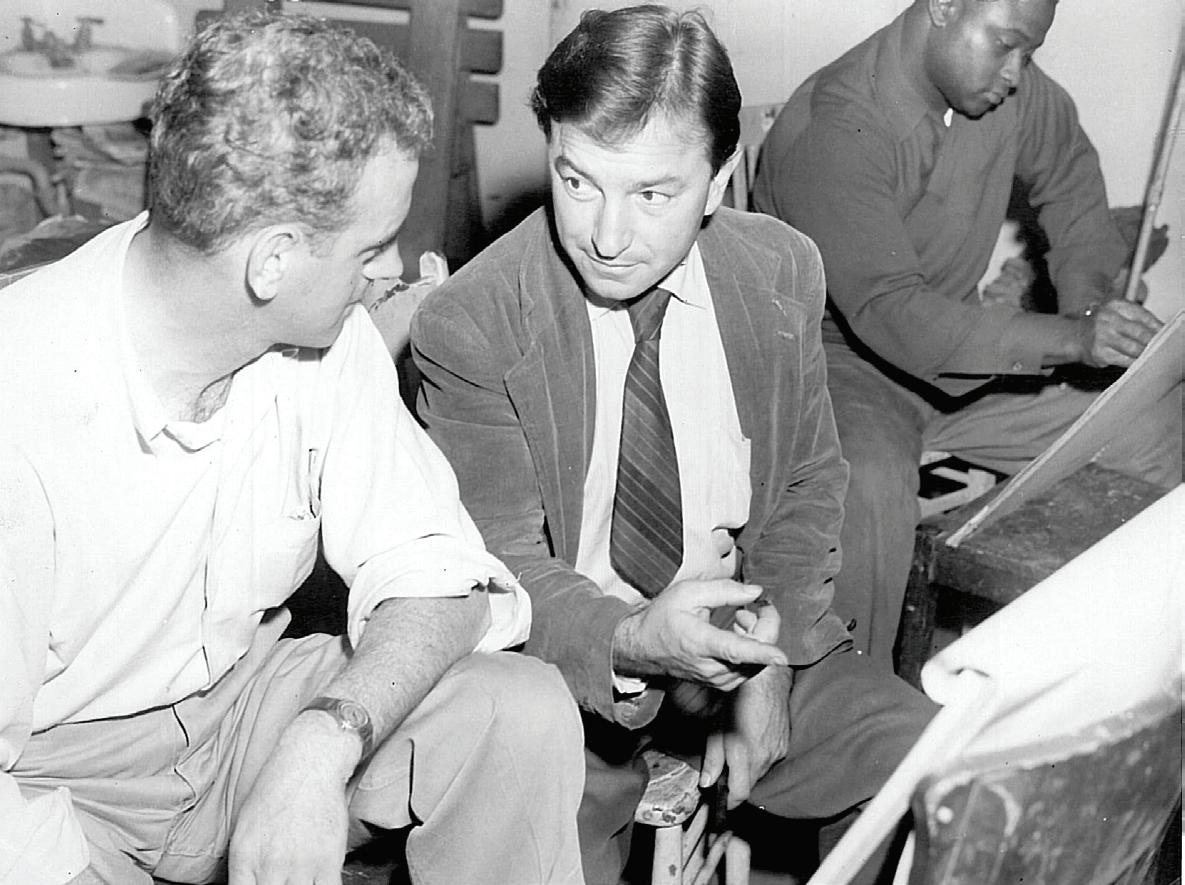
5 minute read
Island Icon: Monty Lewis
In Coronado, the arts were flourishing in the mid-20th century. Across the United States, public art projects of the 1930s and 40s ushered in a uniquely American aesthetic. American artists were no longer taking cues from Europe, and public funding was cultivating art projects. The sponsorship of artists during the Depression and World War II brought artists from all over the nation to Coronado’s village.
Monty Lewis, who later became Coronado’s most famous artist, came to the island during World War II. Lewis moved his family from New York to Coronado to join the Consolidated Vultee Aircraft Corporation in 1942. The company produced aircraft such as the PBY Catalina seaplane for the U.S. Navy. He worked as a technical illustrator in the industrial engineering department.

Lewis, a native of Wales, was born in 1907 and immigrated to America as a teen. He first studied art at the Art Students League of New York. Soon, he became a nationally known painter and muralist. He received a Guggenheim Fellowship in 1930 to study architecture and he went on to produce exhibitions at the Museum of Modern Art, the Chicago Art Institute, and the Whitney Museum. He was also commissioned to create a mural at the Museum of Man Building for the 1939 New York World’s Fair.
During the Depression, Lewis was hired under the Works Progress Administration (WPA), one of President Roosevelt’s New Deal agencies. The WPA was created by Executive Order to fund state and local public works projects. The WPA’s Federal Arts Project (under Federal Project Number One) included the employment of thousands of artists like Lewis to contribute to public works of art in their community. Through this program, Lewis is known to have been commissioned for at least two fresco murals. A large double fresco depicting “The Cotton Industry in Contemporary America” was completed in 1936 at Brooklyn High School of the Arts. He also installed four mosaics collectively titled “Youth Carrying the Heritage of the Past into the Future,” which were located at Trenton Central High School in New Jersey in 1941. One year after the completion of the mosaics, he moved his family to Coronado.
After the war, Lewis remained in Coronado, settling his family and reinventing his life of art. In 1945, he established the Coronado School of Fine Arts. He held morning, evening, and weekend classes for children and adults. Aware of the challenges faced by military servicemen and women returning from war and understanding art’s influence on recovery, he advertised the classes as “Approved for Veterans.” Lewis remained the director of the school for more than forty-five years, reaching hundreds of aspiring Coronado artists.
Monty Lewis’ School of Fine Arts was a premiere art school for both amateurs and professionals honing their craft. The school provided multi-year courses in commercial art, fine arts, and graduate studies. According to the Smithsonian’s Archives of American Art, it was considered to be the only American school teaching the art of fresco at the time of its founding. Though the school did not award degrees, the art community recognized the school’s quality of instruction. Lewis’ connections and kinships brought artists with national reputations to teach courses.

The school was never subsidized with public or private funds. The school collected a modest tuition to finance operations. After a few years, Lewis wanted to raise money for scholarships aimed at attracting students from throughout San Diego County.
Monty Lewis’ profound influence on the arts community of Coronado eventually led to the foundation of the Coronado Art Association. As a founding member, Lewis served as the Association’s first president.
Formed in 1948, the group was the first established organization of artists in Coronado. They were the first to define themselves as a separate art community. Before the war, the artists of Coronado held strong ties to Balboa Park in San Diego because it was the primary exhibition space in the county.
The Coronado Art Association was different.
The Art Association celebrated and supported artists on the island. They also attracted outside talent. The Jeannette Galleries located at 1115 Orange Avenue was the Art Association’s first public exhibition space. Prior, exhibits at the Hotel del Coronado and Dayton Brown’s studio were open by invitation only.
In 1950, Lewis devised a fundraiser for the School of the Arts with his colleagues from the Art Association. The school jointly sponsored the First Annual Arts Costume Ball with the Coronado Art Association. Held in the ballroom of the Hotel del Coronado, the fanfare and spectacle of the Ball included decorations designed by students. The fun of the evening went on until 1:00 am. The first Ball was such a hit that it
became an annual Coronado tradition through the early 1980s.

Monty Lewis’ legacy still exists in the Coronado of today. The school dissolved in 1990, but Coronado High School incorporated an art school within its system. The Coronado School of the Arts (CoSA) opened later in the 1990s and continues to prosper. At the school, students supplement their high school experience with technical arts training.
The Coronado Art Association also continues to thrive. They host the bimonthly Art in the Park event. The City of Coronado’s Arts Commission, founded in 2012, concentrates on supporting and promoting local arts. Their public art program is ever-expanding. The arts continue to flourish thanks to Lewis’ influence.









